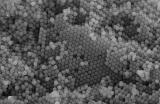
Proteomics, the study of protein structure and function, is an important aspect of biological knowledge and thus the development of improved medical diagnostic and treatment methods. One of the challenges that researchers face in proteomics is the speed with which proteins can be separated. Conventionally, proteins are separated using high performance liquid chromatography (HPLC), which involves passing a solution of proteins through a column packed with solid particulates typically around 5μm in diameter. The proteins are variously attracted to the solid particles, and the proteins that are least attracted come out from the other end of the column first, while the proteins that are most attracted to the particles come out last. The entire process can take over an hour for one sample.
At the 42nd Western Regional Meeting of the American Chemical Society, Malkin et al., from the University of Arizona, reported a new method for protein separation that uses nanoparticles to replace the 5 μm diameter particulates that are currently used. They modified silica nanoparticles (shown in image) with various functionalities for use with pressure- and electrically-driven chromatography as well as hydrodynamic chromatography. This new method enabled separation of proteins with a column length that was about ten times shorter than those used in conventional methods, which would translate into protein separations that are approximately 10 times faster. They continue to investigate ways to overcome the main drawback to the new technique: the high pressures needed to push the protein solution through the packed nanoparticles.
Increased speed of protein separations would help researchers sift through the multitudes of proteins in the body to identify proteins that signal diseases. Once a protein has been identified as a marker for a given disease, diagnostic tests based on the high speed separation could be developed for rapid screening of blood samples.
Malkin, D.S., Uhlenkamp, J.M., Wirth, M.J. “High-Speed Separations Inside Capillaries Packed with Silica Colloidal Crystals” 42nd Western Regional Meeting of the American Chemical Society, 2008.
More information available here.
Image used with permission from Dr. Mary Wirth.
